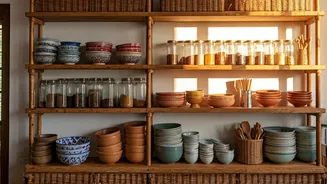Repurposed Containers
In many rural Indian homes, reusing materials is a way of life, and this extends to the kitchen. Old glass jars, tin cans, and even plastic containers
that once held other food items are cleverly repurposed for storage. These containers are ideal for storing dry goods like lentils, spices, and flours. They can be labeled clearly to identify contents easily. This method helps to organize pantry items and reduces waste. Using repurposed containers adds a touch of rustic charm to the kitchen while minimizing the carbon footprint. These containers are often stored on open shelves or in cabinets, ensuring easy access to frequently used ingredients. Their varied sizes allow for efficient space utilization, accommodating different quantities of food items.
Wall-Mounted Solutions
Rural Indian kitchens often utilize vertical space to the fullest. Wall-mounted storage systems are common, maximizing available space. These can range from simple wooden shelves to more elaborate systems built from bamboo or reclaimed wood. Often, cooking utensils such as ladles, spoons, and spatulas are hung on hooks attached to the wall. This keeps them readily accessible and frees up drawer space. Pots and pans are sometimes suspended from the ceiling or mounted on walls, which optimizes accessibility and frees up countertop space. This approach promotes a tidy and well-organized kitchen area. These solutions are customized to fit the specific needs of the family and the dimensions of the kitchen.
Hanging Baskets
Hanging baskets, often made from woven materials like bamboo or cane, are a practical storage solution. These are typically used to store fruits, vegetables, and sometimes onions and garlic. The hanging design keeps these items off the counter and allows for good air circulation, which helps to preserve their freshness. These baskets are usually suspended from the ceiling or attached to a wall, maximizing vertical space. Their open design allows for easy visibility and access to the stored items. They bring a touch of natural aesthetics to the kitchen and add to its overall functionality. Baskets can also be used to store smaller items, helping to keep countertops clear.
Multi-Purpose Shelves
In many rural Indian households, shelves are not just for storing items but often serve multiple purposes. These shelves might hold everything from dishes and spices to cooking utensils and ingredients. They are usually constructed from readily available materials, such as wood, and are designed to maximize storage capacity. Shelves are often customized to fit the kitchen’s dimensions, thereby utilizing every inch of available space. They are frequently open, making items easily visible and accessible, contributing to an organized and efficient cooking environment. A well-organized shelf makes it easy to locate and retrieve any needed ingredient or tool, streamlining the cooking process.
Spice Racks
Spices are integral to Indian cooking, and in rural kitchens, they are stored with care and consideration. Spice racks are an important storage solution, frequently designed to hold numerous spice containers in an organized manner. They can range from simple wooden racks to more sophisticated arrangements with multiple tiers and compartments. Spices are usually stored in airtight containers to preserve their aroma and flavor and to protect them from moisture and pests. The spice rack is often placed near the cooking area, making it easy to reach for ingredients during the cooking process. Their strategic placement ensures that cooking is efficient and streamlined. This setup facilitates easy identification and accessibility for quick cooking.
Under-the-Sink Storage
The space under the sink, often underutilized, is creatively employed for storage in rural Indian kitchens. This area is utilized to store cleaning supplies, such as soaps, detergents, and brushes, and sometimes even kitchen tools and extra food supplies. Simple shelves or baskets are often added to enhance storage capacity and keep items organized. To protect the stored items from moisture, the area is frequently lined with waterproof materials. This ensures the longevity of both the supplies and the cabinetry. Such organization maximizes otherwise wasted space and keeps cleaning essentials close at hand. This storage strategy optimizes the functionality of the kitchen and creates a cleaner and more efficient work area.















